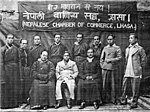History of Newar
For about a thousand years, the Newar civilization in Central Nepal preserved a microcosm of classical North Indian culture in which Brahmanic and Buddhist elements enjoyed equal status. Snellgrove and Richardson (1968) speak of 'the direct heritage of pre-Islamic India'. The Malla dynasty was noted for their patronisation of the Maithili language (the language of the Mithila region) which was afforded an equal status to that of Sanskrit in the Malla court. Maithil Brahmin priests were invited to Kathmandu and many Maithil families settled in Kathmandu during Malla rule. Due to influx of people from both north (Tibet) and south (Tirhut) who brought with them not only their genetic and racial diversity but also greatly moulded the dominant culture and tradition of Newars.
The different divisions of Newars had different historical developments. The common identity of Newar was formed in the Kathmandu Valley. Until the conquest of the valley by the Gorkha Kingdom in 1769, all the people who had inhabited the valley at any point of time were either Newar or progenitors of Newar. So, the history of Newar correlates to the history of the Kathmandu Valley (or Nepala Mandala) prior to the establishment of the modern state of Nepal.
The earliest known history of Newar and the Kathmandu Valley blends with mythology recorded in historical chronicles. One such text, which recounts the creation of the valley, is the Swayambhu Purana. According to this Buddhist scripture, the Kathmandu Valley was a giant lake until the Bodhisattva Manjusri, with the aid of a holy sword, cut a gap in the surrounding hills and let the water out.[29] This legend is supported by geological evidence of an ancient lakebed, and it provides an explanation for the high fertility of the Kathmandu Valley soil.
According to the Swayambhu Purana, Manjusri then established a city called Manjupattan (Sanskrit "Land Established by Manjusri"), now called Manjipā, and made Dharmākara its king. A shrine dedicated to Manjusri is still present in Majipā. No historical documents have been found after this era till the advent of the Gopal era. A genealogy of kings is recorded in a chronicle called Gopalarajavamsavali. According to this manuscript, the Gopal kings were followed by the Mahispals and the Kirats before the Licchavis entered from the south. Some claim Buddha to have visited Nepal during the reign of Kirat King Jitedasti. Newar reign over the valley and their sovereignty and influence over neighboring territories ended with the conquest of the Kathmandu Valley in 1769 by the Gorkhali Shah dynasty founded by Prithvi Narayan Shah.
Prior to the Gorkha conquest, which began with the Battle of Kirtipur in 1767, the borders of Nepal Mandala extended to Tibet in the north, the nation of the Kirata in the east, the kingdom of Makwanpur in the south[35] and the Trishuli River in the west which separated it from the kingdom of Gorkha.[36]
Economic history
Trade, industry and agriculture have been the mainstay of the economy of the Newars. They are made up of social groups associated with hereditary professions that provide ritual and economic services. Merchants, craftsmen, artists, potters, weavers, dyers, farmers and other castes all played their part in creating a flourishing economic system. Elaborate cultural traditions which required the use of varied objects and services also fueled the economy. Towns and villages in the Kathmandu Valley specialized in producing particular products, and rich agriculture produced a surplus for export.
For centuries, Newar merchants have handled trade between Tibet and India as well as exporting locally manufactured products to Tibet. Rice was another major export. Porters and pack mules transported merchandise over mountain tracks that formed the old trade routes. Since the 18th century, Newars have spread out across Nepal and established trading towns dotting the mid hills. They are known as jewelry makers and shopkeepers. Today, they are engaged in modern industry, business and service sectors.

0 Response to "History of Newar | Newari Culture"
Post a Comment
Thank you !!
Share with others